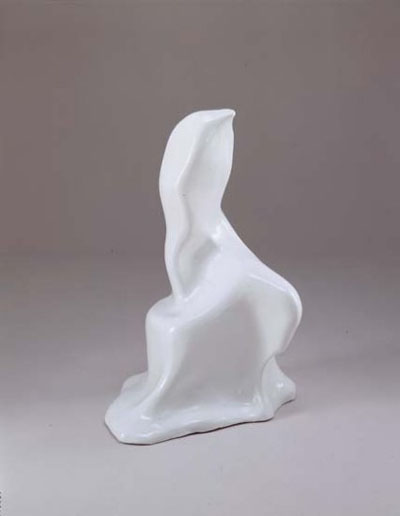 Melissa McGill Figurines have been a perennial human obsession across time, culture, and history, from the earliest known examples of private icons and fetishes to the legendary Golem of Jewish folklore. Porcelain figurines produced in the nineteenth century represented an entirely new art form in a much-coveted medium (that at one time was as alchemically elusive and as valuable as gold). These figurines took their inspirations from contemporary painting, illustrious subjects, characters from the Commedia dell'Arte, and so on. Today, this genteel repertoire has expanded to include an endless parade of figures from popular culture including Alien, Manga heroes, soft-porn stars, Spiderman, even The Simpsons. Perhaps, as Bruce Chatwin implies in his novel Utz, the human fascination for these figurines endures and proliferates because they seem more real and invulnerable than the world beyond them. Melissa McGill's fascination with figurines and the spatial voids and vacuums that surround them, expresses itself in compelling sculptures and drawings that physicalize her explorations in an Antipodean world of surrogates and their corresponding negative space. By referring to voids, surrogates and shadows, McGill consciously connects to a vast web of references to do with the rhetoric of the ephemeral or eidetic image - the trace, the copy, the opposite, the reflection, the theatrical impersonation, the illusion, the outline, the dependent or contingent symbol - in short, the virtual as opposed to the substantial image. And, equally, the human psyche, Jung's archetypal definition of the personal unconscious, and the Saturnian aspects of the personality as formed by repressed fears and unpleasant emotions. Given her interests, then, it is not surprising that McGill's process revolves principally around the technique of casting and the constant vacillation between positive and negative space that this technique involves. Working to unite visible dimensionality with its invisible counterpart, and at the same time collapse the perceived distinctions between high and low art, McGill derives a new and quite unfamiliar artistic vocabulary from a common, even banal, language of form. In one instance, she calibrates and materializes the airy gaps within and between the dance of Canova's Three Graces to create a free-standing three-dimensional ensemble of suspended glass vessels; in another, she renders the deep folds and recesses of Bernini's High Baroque sculpture The Ecstasy of St Teresa in flat cast silicon fragments "drawn" directly onto the wall in a vast and dynamic anamorphic splash; in yet another, she everts and fills the hollow interiors of cute novelty figurines to produce strangely disturbing abstract figures, vague morphic resonances of their former selves. A recent residency at the Kohler industrial porcelain factory in Wisconsin enabled McGill to explore her ideas on a much larger scale, with spectacular results. Assisted by company artisans, she produced a series of unique porcelain sculptures, almost human-size. Continuing to work with the idea of positive casting the interior spaces of figurines, but on a massively amplified scale, she has created the very image of how we have been taught to imagine ghosts - spotlessly white ectoplasmic statues that, despite their extreme weight and lapidary hardness, seem to melt away before our very eyes. In creating such visceral visual experiences in "otherness", might the sculptural events of Melissa McGill then lead us to consider the unreckoned with spaces and forces of our own lives? Melissa McGill was born in Rhode Island in 1969 and now lives and works in Brooklyn, New York. This will be her first major exhibition in Europe. May 6 - 31, 2003 Hours: Tue-Sat 10 am - 6 pm White Cube 48 Hoxton Square GB-London N1 6PB Telefon +44 020 7930 53 73 Fax +44 020 7749 74 80 www.whitecube.com |